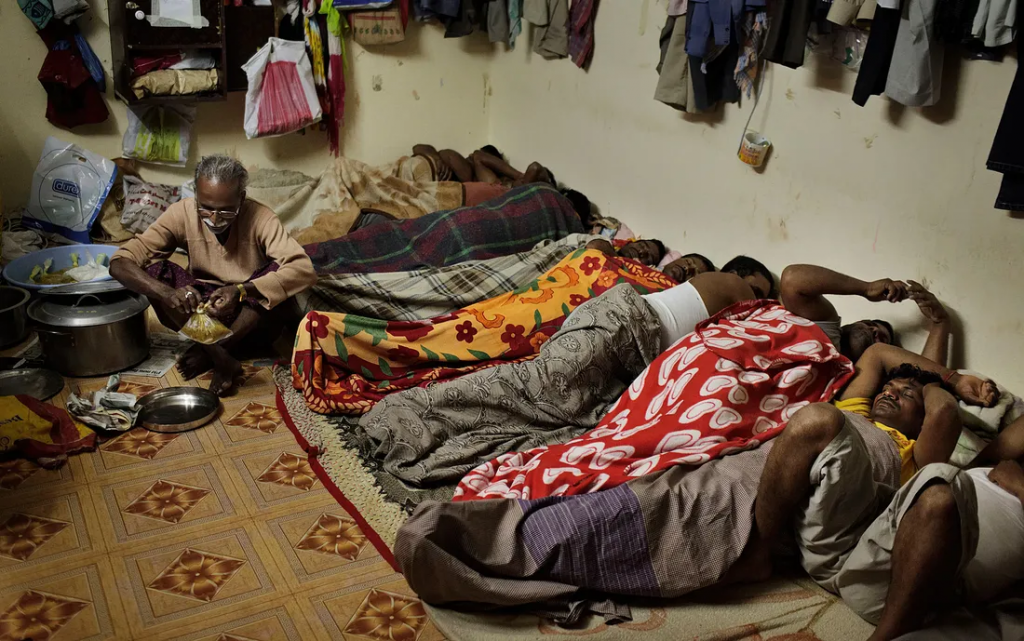Dubai, the glistening jewel of the United Arab Emirates, is often portrayed as a land of luxury, prosperity, and opportunity. With its towering skyscrapers, extravagant malls, and a GDP exceeding $100 billion, it presents an alluring facade. To many, especially those living in poverty-stricken countries, it offers the promise of a better life: high-paying jobs, comfortable accommodations, and a chance to escape the crushing weight of debt. Unfortunately, for many migrant workers, this dream quickly becomes a nightmare, exposing the harsh reality hidden beneath Dubai’s opulent surface.
The Journey to Dubai: A Ticket to Slavery
For many migrants, the journey to Dubai begins with immense sacrifice. Workers toil for months, saving every penny to cover the cost of migration fees, flights, and visa expenses. They bid emotional farewells to their families, hoping to return with the means to provide a better life for their loved ones. The journey, which often spans thousands of miles, ends at the luxurious Dubai International Airport, where a representative from their new employer awaits with a card bearing their name.
However, this welcoming gesture soon turns sinister. The worker’s passport is immediately confiscated “for safekeeping,” a chilling act that essentially strips them of their freedom. From this point forward, they are trapped in a system designed to exploit them, with no way to return home and little recourse for escape.
The Kafala System: Legalized Bondage
At the heart of the exploitation of migrant workers in Dubai is the kafala system, a labor framework that ties workers to their employers. Under this system, employers wield immense control over the lives of their workers. This includes the ability to dictate immigration status, approve or deny work permits, and, perhaps most egregiously, control their right to exit the country. Workers, many of whom migrate to Dubai seeking better opportunities, are often unaware of the legal and financial trap they are walking into.
Once their passports are confiscated, workers are left at the mercy of their employers, unable to leave the country without permission. The system, which effectively turns employees into indentured servants, offers no legal protection for workers. Those who dare to complain or resist face severe consequences, ranging from deportation to financial ruin.
The Reality of Labor Camps
While Dubai’s skyline is a testament to human ingenuity and architectural brilliance, these towering monuments to wealth are built on the backs of exploited laborers. Workers like Farhan, a man from Pakistan, soon discover that their dreams of a better life were nothing more than an illusion. Upon arrival, they are transported to labor camps far removed from the glittering city, hidden from the eyes of Emirati citizens and Western tourists.
These camps, often described as ghettos, are cramped, unsanitary, and overcrowded. Workers are herded into tiny dormitories with metal bunk beds, where dozens of people share limited living space. Outside, the camps are fenced off, guarded by security personnel employed by the very companies exploiting these workers. These are not homes, but prisons, where workers are held captive and forced to live in squalor.
A Living Hell: Daily Life as a Migrant Worker
Once workers are confined to these camps, they are subjected to grueling labor conditions. Farhan, like many others, was assigned to work on construction sites, helping build the very skyscrapers that define Dubai’s skyline. In the blistering heat, where temperatures can soar to 110°F (43°C), workers labor for 12 hours a day, seven days a week, with little rest and inadequate pay.
For their efforts, workers are often paid a meager wage, sometimes as little as $175 per week. This is a far cry from the high wages they were promised before arriving in Dubai. In many cases, employers withhold wages for months, leaving workers in a state of financial desperation. Unable to send money back home to support their families, many workers sink deeper into debt, trapped in a vicious cycle of poverty and exploitation.

Death on the Job: The Harsh Reality of Labor
The extreme working conditions in Dubai’s construction and service industries often lead to exhaustion, injury, and even death. Every week, an estimated 10 migrant workers die in the UAE, succumbing to the brutal demands placed upon them. Many of these deaths go unreported, as Emirati authorities have taken steps to suppress the true scale of the human cost behind the city’s rapid development.
In some cases, workers are so desperate and broken by their circumstances that they take their own lives. One such tragedy occurred in 2011, when an Indian expatriate working as a cleaner at the Burj Khalifa, the world’s tallest building, jumped from the 147th floor after being denied a holiday request. His death was just one of many in a long line of suicides among migrant workers in Dubai, a grim testament to the unbearable conditions they endure.
The Debt Trap: No Escape
For many workers, the hope of returning home fades as the reality of their situation sets in. Even though their contracts often promise a final payout to cover the cost of a flight home, this payment is frequently delayed or denied altogether. Without their passports and with no savings to speak of, workers are left with no means to escape.
The kafala system ensures that workers remain tethered to their employers, unable to seek help or leave the country without risking severe consequences. For Farhan, the thought of returning to Pakistan and reuniting with his family became a distant dream. His only option was to continue working, enduring the endless cycle of exploitation in the hope that one day, he might finally be allowed to leave.
A System of Modern-Day Slavery
The story of Farhan and countless other migrant workers in Dubai is a tragic reflection of the exploitation that exists in the shadows of one of the world’s wealthiest cities. The kafala system, combined with corrupt recruitment practices and a lack of legal protections, has created a system of modern-day slavery. Workers are lured to Dubai with the promise of a better life, only to be trapped in a cycle of debt, forced labor, and abuse.
While Dubai’s rulers and wealthy elite continue to prosper, the human cost of their success is paid by the thousands of migrant workers who toil in silence. Stripped of their dignity, freedom, and rights, these workers live and die in conditions that should have no place in the modern world.

As the world continues to marvel at Dubai’s wealth and architectural wonders, it’s important to remember the true cost of these achievements. Behind the glittering facade of luxury lies a hidden world of suffering, where workers like Farhan are trapped in a life of exploitation. Their stories serve as a stark reminder that, despite the promises of a better life, for many, Dubai is nothing more than a gilded cage—a city built on the blood, sweat, and tears of the powerless.

